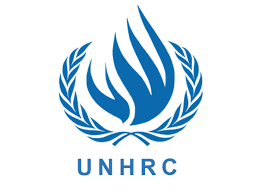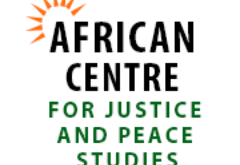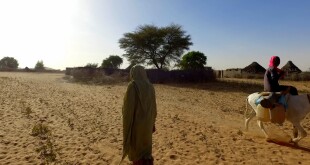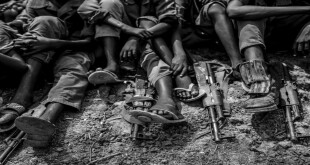(21 September 2022) The conflict in Ethiopia that began in November 2020 has driven an estimated 59,501 refugees into Sudan.[1] Most of these arrived in the early days of the war, but new refugee arrivals were recorded in early September following the resumption of hostilities in late August.[2] Most of these (90%) are Tigrayan, but a number of other ethnicities are also represented in the refugee population. Most of the refugees (49,833) are hosted in Kassala and Gedaref states in eastern Sudan, with most of the remainder hosted in Blue Nile state.[3]
These new arrivals entered a context in Sudan where they are a minority of the total 1.1 million refugees in the country, most of which are from South Sudan.[4] Even in eastern Sudan, where most of them are based, there are also an estimated 133,000 refugees, mostly Eritreans, also present in the region.[5]
Ethiopians fleeing the ongoing conflict are also joining large populations of both former refugees and labor migrants. Unofficial estimates indicated that over 600,000 participate in seasonal migration schemes each year.[6]
In this context, Ethiopia refugees face numerous challenges. There are challenges to accessing humanitarian assistance, to their security and to their rights.
Humanitarian situation
Ethiopian refugees have arrived in a country which is facing devastating humanitarian needs. 11.7 million people are estimated to be severely food insecure throughout the country[7] with economic crisis, mismanagement of government subsidies for food production and war in Ukraine all playing a role.[8] Refugees are particularly affected. Due to serious funding shortfalls, the World Food Programme has been forced to cut food rations across Sudan to half of the regular basket.[9]
In addition, both Sudanese and refugee children are facing issues with access to school. An estimated 6.9 million children in Sudan, one third of the total, are out of school.[10] Even before the recent influx, educational programs for migrant and refugee programs were seriously under-resourced and 18% of displaced and migrant children in Sudan said that they wanted to go to school but were unable to.[11]
Security concerns
Another key concern facing the refugee population in Sudan has been security. There have been significant tensions between Sudan and Ethiopia over the Al Farshaga border region. These have had an impact on border management, with, for example, the Gallabat border crossing closing for the first half of 2021.[12] In June 2022, the Sudanese Army accused their Ethiopian counterparts of executing seven captured Sudanese soldiers and one civilian and publicly displaying their bodies. The incident sparked the withdrawal of the Sudanese ambassador to Ethiopia.
Although Burhan and Abiy met on the sidelines of the IGAD summit in July to reduce tensions,[13] the tensions remain along the border and could affect pathways for refugee movement into Sudan. In particular, border closures are likely to have the effect of pushing desperate refugees to increase their use of smugglers, which exposes them to a range of human rights violations.
Recently, hostilities between TPLF forces and Afar militias occurred near the Ethiopia/Sudan border.[14] Similar to the cross-border tensions, tensions along the border could impact on decisions about how and when to move across the border.
An additional security concern has been the possibility of infiltration of armed groups into refugee populations, which can undermine the civilian and humanitarian character of asylum and to provide essential services. There are concerns about the potential presence of Tigrayan forces among civilian refugees. A number of individuals with military experience have sought asylum in Sudan. 528 Tigrayan peacekeepers in Abyei refused to return to Ethiopia in April 2022 citing security concerns.[15] Allegations have been made that some of the troops participating in recent TPLF/Afar militias along the Sudanese border. In addition, the UNHCR has reported that forced military recruitment has been taking place in refugee camps in eastern Sudan. The Sudanese government has denied the presence of TPLF on its territory.[16]
If the civilian and humanitarian character of asylum is undermined then suspicion can fall on refugees as a group, undermining their rights and safety.
Legal status
Although Sudan’s 2014 Regulation of Asylum Act is relatively progressive, it contains significant gaps that can undermine the rights of refugees. The Act defines a refugee in conformity with the 1951 UN and 1969 OAU Conventions. However, it also provides that those seeking refugee status must register at the nearest office of the Commission on Refugees within 30 days of arrival. Some refugees may find this difficult due to lack of familiarity with the process, fear of authority, etc. If they fail to register, they may become legally vulnerable, and this vulnerability may discourage them from accessing assistance. The law also restricts freedom of movement within the country, providing that refugees may not “leave the place which is specified for his residence unless permission from the Commission or from its delegate is obtained.”[17] This can leave refugees facing an impossible choice, either languishing in camps with legal status but few economic opportunities or long term integration options or onward migration which may require the use of smugglers and/or illegally remaining where they end up.
Prior to the crisis, Ethiopian migrants were also vulnerable to a lack of legal status. Although work permits were relatively easy to access, difficulties and expenses related to extending month long individual permissions left migrants illegal and concerned about the potential for arrest in mass roundups (kasha).[18]
Many Ethiopians in Sudan (46%) reported having used a smuggler to get into Sudan. This is not the end of their engagement, however. Due to the difficulty of the situation in Sudan, particularly in the refugee camps, many migrants consider onward motion from Sudan on to other areas. In a recent survey of Ethiopian refugees and migrants in Sudan only 8% said that they had reached the end of their journey. Fifty two percent expressed a desire to continue moving onward and 39% said that they did not know.[19] Smugglers also facilitate movement within the country. Prior to the start of the conflict in Tigray, in 2018, it was estimated that 60% of Eritrean refugees in the east moved on within two months of their arrival in Sudan.[20]
Trafficking from eastern Sudan has also been a serious problem. Kidnappings and abductions have been reported from Shagarab, Fetaw Eshrin and Umgurgur camps in Sudan.[21] There was reportedly also collusion by Sudanese forces. This business is reportedly dominated by the Rashaida, a nomadic group living in both Sudan and Eritrea.[22]
International donors should:
- Ensure that programming to ensure critical humanitarian needs like food, health care and education are adequately funded.
- Advocate with the government of Sudan to adopt laws and policies that uphold refugee rights.
The government of Sudan should:
- Ensure unimpeded humanitarian access to refugee populations.
- Take robust action to prevent, and ensure accountability for, trafficking in human beings.
- Ensure freedom of movement for refugees in accordance with their international rights and to decrease demand for smuggling.
The Government of Ethiopia as well as Tigray People’s Liberation Front (TPLF) should:
- Cease fire and start peace dialogue to prevent more displacement and forced migration and to pave the way for the voluntary return of refugees to their place of origin.
[1] UNHCR, “Ethiopian Emergency Situation Update,” 31 August 2022, https://data.unhcr.org/en/documents/details/95597
[2] Radio Dabanga, “Dozens of refugees enter Sudan after renewed violence in Ethiopia,” 2 September 2022, https://reliefweb.int/report/sudan/dozens-refugees-enter-sudan-after-renewed-violence-ethiopia
[3] UNHCR, “Ethiopian Emergency Situation Update,” 31 August 2022, https://data.unhcr.org/en/documents/details/95597
[4] UNHCR data portal, visited 19 September 2022, https://data.unhcr.org/en/country/sdn
[5] UNHCR, “Regional Refugee Preparedness and Response Plan for the Ethiopia Situation (Tigray),” 22 December 2020, https://data.unhcr.org/en/documents/details/83854
[6] BMM, “4th Cross Border Workshop on Seasonal Labour Migration in Gedaref State,” 18-19 March 2019, on file with author.
[7] OCHA, “Sudan Situation Report,” 19 September 2022, https://reliefweb.int/report/sudan/sudan-situation-report-19-sep-2022
[8] Arif Elsaui, “Sudan’s Food Crisis: Contributing Factors and Political Ramifications,” Sudan Transparency and Policy Tracker, July 2022, https://mcusercontent.com/b3101ea3866029414729ab5e5/files/2cedd62c-c11f-fff7-8939-dab470ab16a8/WheatAlert_Laid_Out_Version.pdf
[9] UN Secretary-General, “Situation in the Sudan and the activities of the United Nations Integrated Transition Assistance Mission in the Sudan,” 2 September 2022, https://reliefweb.int/report/sudan/situation-sudan-and-activities-united-nations-integrated-transition-assistance-mission-sudan-report-secretary-general-s2022667-enar
[10] Save the Children, UNICEF, “Joint Statement: Urgent action needed as 6.9 million children are out-of-school and 12 million face learning disruptions,” 12 September 2022, https://reliefweb.int/report/sudan/joint-statement-urgent-action-needed-69-million-children-are-out-school-and-12-million-face-learning-disruptions
[11] UNICEF: Office of Research – Innocenti, “Reimagining Migration Responses in Sudan,” 2021, https://www.unicef-irc.org/publications/pdf/Reimagining-migration-responses-in-Sudan-learning-from-migrant-children.pdf
[12] OCHA, “Gedaref State Profile,” March 2022, https://reliefweb.int/report/sudan/sudan-gedaref-state-profile-updated-march-2022
[13] UN Secretary-General, “Situation in the Sudan and the activities of the United Nations Integrated Transition Assistance Mission in the Sudan,” 2 September 2022, https://reliefweb.int/report/sudan/situation-sudan-and-activities-united-nations-integrated-transition-assistance-mission-sudan-report-secretary-general-s2022667-enar
[14] ACLED, “Ethiopia Peace Observatory Weekly: 13 August – 9 September 2022,” 16 September 2022, https://reliefweb.int/report/ethiopia/ethiopia-peace-observatory-weekly-13-august-9-september-2022-enam
[15] ACLED, “Ethiopia Peace Observatory Weekly: 13 August – 9 September 2022,” 16 September 2022, https://reliefweb.int/report/ethiopia/ethiopia-peace-observatory-weekly-13-august-9-september-2022-enam
[16] ACLED, “Ethiopia Peace Observatory Weekly: 13 August – 9 September 2022,” 16 September 2022, https://reliefweb.int/report/ethiopia/ethiopia-peace-observatory-weekly-13-august-9-september-2022-enam
[17] The Asylum Regulation Act 2014, available at https://static1.squarespace.com/static/5831e53a6b8f5bca573b84b2/t/585ab450ebbd1a4dd38f9bf9/1482339409078/Sudan-asylum-act-2014.pdf (accessed 7 December 2019).
[18] Ahmed Gamal Eldin and Tadele Ferede, “Assessment of Seasonal Migration Management on the Sudanese Border,” Final Report, June 2018, on file with author.
[19] Mixed Migration Centre, “The use of smugglers among Ethiopian refugees and migrants in Sudan,” May 2022, https://reliefweb.int/report/sudan/use-smugglers-among-ethiopian-refugees-and-migrants-sudan
[20] UNHCR (2014), ‘Live, Learn & Play Safe: Regional Initiative 2014-2016 – Protecting Children at Risk in Egypt, Ethiopia, Sudan and Yemen’ at p. 4, 15. Available at: https://www.refworld.org/pdfid/53bbc6314.pdf, cited in ISS, “Sudan Report: Preliminary mapping of services provided to children on the move, with a focus on cross border considerations,” December 2019.
[21] Forcier Consulting, “Baseline Survey for the Quality Services for Vulnerable Migrants and at Risk Children in the Eastern States,” 2018, on file with author.
[22] International Refugee Rights Initiative, “Tackling the Root Causes of Human Trafficking and Smuggling from Ethiopia,” November 2017, p. 14, available at http://refugee-rights.org/wp-content/uploads/2017/11/IRRI-KP-final.pdf
 African Centre for Justice and Peace Studies ACJPS | المركز الافريقي لدراسات العدالة و السلام
African Centre for Justice and Peace Studies ACJPS | المركز الافريقي لدراسات العدالة و السلام




